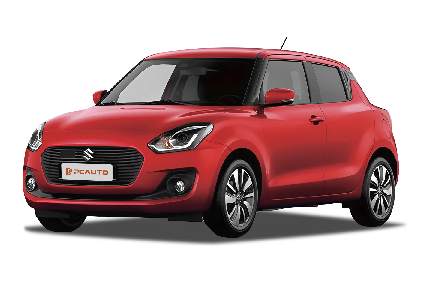Q
What's the weight of the Suzuki Swift?
Depending on the model year and trim level, the Suzuki Swift's curb weight in the Malaysian market typically ranges from around 890 kg to 1,020 kg. The exact figure varies based on the specific variant and powertrain setup – for instance, base models with the 1.2L naturally aspirated engine tend to be lighter, while versions equipped with extra comfort features or hybrid systems tip the scales a bit more.
Weight plays a big role in how a car handles and sips fuel, and the Swift's lightweight design really shines in city driving. It delivers nimble steering and impressive fuel economy, making it a solid fit for Malaysia's twisty roads and stop-and-go traffic. What's more, Suzuki's use of lightweight yet high-strength steel not only keeps the body rigid and safe but also helps keep maintenance costs in check.
If fuel efficiency is a top priority, keep an eye on the official figures – they usually land between 18km/L and 22km/L. In a market like Malaysia where fuel prices can swing pretty often, that kind of frugality gives the Swift a clear edge when it comes to long-term running costs.
Special Disclaimer: This content is published by users and does not represent the views or position of PCauto.
Related Q&A
Q
How many litres of oil does a Suzuki Swift take?
Alright, car enthusiasts and Suzuki Swift owners in Malaysia, let's talk oil. Typically, your Swift's engine will take around 3.3 to 3.5 liters of oil. The exact amount can vary a bit depending on the model year and, more importantly, the engine under the hood – think 1.4L versus 1.5L units. To be 100% sure, always crack open your owner's manual or have a chat with your authorized Suzuki service center.
Living in Malaysia, where the heat can really crank up, staying on top of oil changes is crucial for keeping your engine happy and healthy. A good rule of thumb is to get that oil swapped out every 5,000 to 10,000 kilometers, or every 6 months, whichever comes first. And when you do, opt for a synthetic oil that meets API SN or SP standards. Trust me, it'll hold up much better in our tropical climate.
Don't forget the basics, either. Regularly check your dipstick to make sure the oil level sits nicely between the minimum and maximum marks. Too much oil, or too little, can both throw a wrench into your engine's performance. And if you notice you're topping up more frequently than usual, don't ignore it. It could be a sign of a leak or some other mechanical gremlin that needs sorting out to keep your Swift running smoothly for the long haul.
Q
What fuel does Suzuki Swift use?
In the Malaysian market, the Suzuki Swift primarily runs on RON 95 unleaded petrol – the most common fuel type there. It's budget-friendly, widely available, and perfectly suits the Swift's engine design. Both the 1.4L naturally aspirated and 1.0L turbocharged engines under the Swift's hood are tuned to work optimally with RON 95, striking a good balance between fuel efficiency and power. Now, if owners occasionally fill up with higher octane RON 97, it won't hurt the engine, but it's just less economical. The Swift's compression ratio isn't high enough to warrant splurging on premium fuel.
Malaysia's fuel standards are strictly regulated by the government, and both RON 95 and RON 97 come with detergents to help minimize carbon buildup. It's best for owners to stick to the manufacturer-recommended fuel grade and keep up with regular maintenance to keep the engine performing at its peak.
Also, fuel consumption can be influenced by the season or driving habits. Aggressive driving or frequent short trips can take a toll on fuel economy, while smooth acceleration and maintaining proper tire pressure can help optimize it. One thing to note: some petrol stations in Malaysia offer biofuel blends (like B7 biodiesel), but these are only intended for diesel-powered vehicles, so petrol car owners don't need to worry about that option.
Q
How many miles are left when the fuel warning light of Suzuki Swift illuminates?
When the fuel light comes on in a Suzuki Swift, it usually means there's roughly 7 to 10 liters of gas left in the tank. How far you can go after that depends on your driving conditions and the specific model, but generally, you're looking at around 80 to 120 kilometers in city traffic. Hit the highway, and you might stretch it to 120 to 150 kilometers.
Pro tip: Once that light pops on, it's best to refuel sooner rather than later. Running too low can mess with the fuel pump, and keeping a steady, smooth driving style will help you squeeze every last kilometer out of that remaining gas.
Keep in mind, tank design and fuel economy vary a bit between Swift models, so your owner's manual is the go-to for the most accurate numbers. And don't sleep on regular maintenance—checking tire pressure, for example, can really boost fuel efficiency and cut down on unnecessary consumption.
Q
How to check power steering fluid in Suzuki Swift?
Checking the power steering fluid level in your Suzuki Swift is a straightforward task. First, make sure the car's parked on level ground and the engine's cooled down. Pop the hood and look for the power steering reservoir—you'll usually find it near the driver's side with a steering wheel icon on it. There are "MIN" and "MAX" lines on the side; the fluid level should sit right between them. If it's below "MIN," top it up with the correct spec fluid—stick with the factory-recommended stuff for best performance, trust me.
Heads up though: if you're constantly having to add fluid, there might be a leak in the system. Get that checked out ASAP to avoid damaging the power steering pump. Also, don't sleep on regular fluid changes—most folks recommend every 2 years or 40,000 km. Letting it go too long can make the fluid break down, which hurts steering responsiveness and shortens the system's lifespan.
Living in Malaysia's hot, humid climate? That means your power steering system's working extra hard. So stay on top of those checks and maintenance to keep things driving safely and smoothly.
Q
What's the specification of the engine of Suzuki Swift?
The Suzuki Swift's engine options in Malaysia vary depending on the model year and trim level. The current mainstream variants are powered by a 1.4-liter K14B naturally aspirated four-cylinder petrol engine, churning out approximately 91 horsepower and 130 Nm of torque. This engine is known for its fuel efficiency and durability, making it well-suited for city commuting. While some international markets offer 1.2-liter or 1.0-liter turbocharged options, the Malaysian Swift lineup primarily sticks with the 1.4-liter unit.
For fuel-conscious buyers, the Swift's lightweight body paired with its small-displacement engine delivers an impressive combined fuel economy of around 18-20 km/l, all while maintaining nimble handling characteristics that make zipping through traffic a breeze. If you're considering a used Swift, earlier models from 2005-2010 might come with a 1.5-liter engine, so it's always a good idea to check the specific configuration using the vehicle's VIN.
Given Malaysia's hot climate, regularly changing the coolant and keeping the cooling system clean are key to extending the lifespan of these smaller engines. Fortunately, the Swift's engine design takes tropical conditions into account, and locally assembled versions undergo specific tuning to adapt perfectly to our environment.
Q
How much horsepower does the Suzuki Swift produce?
The Suzuki Swift currently on sale in Malaysia comes equipped with a 1.4-liter K14B naturally aspirated engine, churning out 92 horsepower and 130 Nm of peak torque. It's mated to either a 5-speed manual or a 4-speed automatic gearbox. This nimble hatchback has won over urban drivers with its fuel efficiency and agile handling.
It's worth noting that the Swift offers different powertrain options across markets. For instance, the Japanese-market Swift Sport packs a punch with a 1.4T turbocharged engine delivering 140 horsepower, though this variant hasn't made its way to Malaysia yet. For Malaysian consumers craving more performance, keep an eye on the Swift's tuning potential. Thanks to its lightweight design (around 900kg) and solid chassis, simple intake and exhaust upgrades can noticeably sharpen throttle response. Just be sure to go with reputable tuning shops to keep your ride reliable.
As a global icon with over 6 million units sold, the Swift's durability and low maintenance costs are added practical perks, especially handy in Malaysia's tropical climate.
Q
What is the fuel consumption of the Suzuki Swift?
The Suzuki Swift's fuel economy varies depending on its engine configuration and driving conditions. The 1.4-liter naturally aspirated version commonly found in the Malaysian market has official combined fuel consumption figures of around 5.4 to 5.7 liters per 100 kilometers. In real-world driving, you might see city fuel consumption creep up a bit to approximately 6.5 liters per 100km, while highway cruising can bring it down to under 5 liters per 100km. Of course, actual fuel usage will be influenced by driving habits, road conditions, and the vehicle's maintenance status.
As a lightweight hatchback, the Swift owes its fuel-sipping nature to efficient engine technology paired with a CVT transmission, making it a solid choice for city commutes. If you're looking to squeeze even more efficiency out of it, regular maintenance is key—think replacing the air filter and using the right viscosity engine oil. Also, avoiding aggressive acceleration or speeding helps, and in Malaysia's hot climate, using the air conditioning moderately strikes a good balance between fuel economy and comfort.
Rivals like the Perodua Myvi or Honda Jazz offer similar fuel efficiency, but the Swift holds its own in the local market with its nimble handling and the tried-and-tested reliability that Japanese cars are known for.
Q
What is the tire pressure of Suzuki Swift?
For Suzuki Swift owners in Malaysia, the recommended tire pressure can be found on the manufacturer's label located on the driver's side door frame or inside the fuel filler cap. Typically, the front tires are suggested to be set between 30 - 33 psi (2.1 - 2.3 bar), and the rear tires between 28 - 32 psi (1.9 - 2.2 bar). However, these figures may vary slightly depending on the model year and specific configuration, for instance, versions equipped with 16 - inch wheels might require 1 - 2 psi higher pressure than those with 15 - inch rims.
It's important to note that Malaysia's tropical climate causes tire pressure to increase as temperatures rise. So, it's recommended to check pressures monthly when the tires are cold (after the vehicle has been parked for 3 hours or driven less than 2 kilometers). When carrying heavy loads on long trips, you can increase the pressure slightly by 2 - 3 psi, but never exceed the maximum limit indicated on the tire sidewall.
Maintaining the correct tire pressure not only improves fuel efficiency by 5% - 10% but also prevents premature wear – such as center tread over - wear from over - inflation or shoulder under - wear from under - inflation. During the rainy season, proper pressure enhances water evacuation, reducing the risk of hydroplaning.
If you frequently drive on rough roads along Malaysia's East Coast or mountainous routes like Genting Highlands, consider fine - tuning pressures based on the manufacturer's recommendations, ensuring that pressures remain consistent across the same axle.
Q
How many setas does the Suzuki Swift have?
The Suzuki Swift is a compact hatchback that's long been a favorite among Malaysian drivers. The latest model on sale comes standard with a 5-seat layout – two up front and a three-person bench in the back – making it ideal for small families or daily commutes. It's known for its nimble handling and impressive fuel efficiency. Even though it's a small car, smart space planning ensures decent legroom for rear passengers, though the middle seat can feel a bit tight on longer journeys.
It’s worth noting that seat designs have varied slightly across Swift model years. For instance, some older versions offered 60:40 split-folding rear seats to expand cargo space, while sportier trims might feature more supportive, contoured seats to up the driving excitement. In Malaysia, the Swift also gives you engine options: a 1.4L naturally aspirated or a 1.0L turbocharged unit, both paired with a lightweight body – a combo that really shines in city driving.
If you’re eyeing a used Swift, I’d recommend checking the seats for wear in person. These cars are often used as ride-shares or daily workhorses here, so they can rack up the miles pretty quickly.
Q
Where is the fuse box of Suzuki Swift?
For Suzuki Swifts sold in Malaysia, the fuse boxes are typically located in two spots—though this can vary slightly depending on the model year and trim. On newer generations (third-gen models from 2017 onwards), the main fuse box lives under the driver’s side dashboard. You’ll need to crouch down and peek behind the trim panel to the left of the steering wheel to spot it. The second fuse box sits in the engine bay near the battery, close to where you add windshield washer fluid.
Before diving into fuse checks, always make sure the ignition is off. Use the plastic fuse puller from your car’s tool kit to yank out any suspected blown fuses—you can usually tell if one’s toast by looking through the transparent casing to see if the metal strip inside is broken. When replacing, always match the amperage rating exactly (like 10A, 15A, or 20A)—using the wrong one could fry your electrical system.
Malaysia’s hot, humid weather can speed up fuse corrosion, so it’s smart to periodically check fuses for critical systems like headlights and air conditioning. If the same fuse keeps blowing, that’s a red flag—you might have a short circuit or a faulty component. In that case, best to head to an authorized service center for a proper diagnosis.
Swift’s electrical setup is pretty modular, and your owner’s manual should have a diagram labeling what each fuse controls (often using a numbering system like F1 to F20). Familiarizing yourself with that can save time when troubleshooting issues with things like the stereo or cigarette lighter socket.
Latest Q&A
Q
What is the difference between the 2024 and 2025 BMW 5 Series?
There are some differences between the 2024 and 2025 BMW 5 Series models. In terms of pricing, the 2024 520i starts at RM 332,800, with the 520i M Sport variant coming in at RM 349,800. The 2025 530i M Sport, on the other hand, is priced at RM 399,800.
Under the hood, the 2024 520i engines deliver either 210PS or 208PS, while the 2025 530i M Sport ups the ante with a 258PS powerplant. Performance-wise, the 2024 models top out at 230km/h and sprint from 0-100km/h in 7.5 seconds. The 2025 model pushes that top speed to 250km/h and shaves the 0-100km/h time down to just 6.2 seconds.
Looking at the specs, some 2024 trims have rear seats with manual adjustments or fixed configurations, whereas the 2025 model gets a 40:20:40 split-folding rear seat setup. Audio systems also see an upgrade: most 2024 models feature Harman Kardon speakers, while the 2025 model steps up to a Bowers & Wilkins surround sound system.
Additionally, the 2025 5 Series hit dealerships on March 13, 2025, and comes with a 2-year unlimited mileage warranty. The 2024 models first arrived on September 2, 2024.
Q
How much is insurance for a 2024 BMW 5 Series?
The insurance cost for the 2024 BMW 5 Series in Malaysia varies based on several factors, typically ranging from RM5,000 to RM15,000 annually. The exact amount depends on the vehicle model (such as 520i, 530e, or M550i), engine displacement, the owner's age, driving record, type of policy (comprehensive or third-party), and the insurance company's discount policies. For instance, the high-performance M550i, with its higher repair costs, will have significantly higher premiums than the entry-level 520i, while the hybrid 530e may qualify for partial insurance discounts due to its eco-friendly features. Additionally, Malaysia's insurance market is influenced by the No Claim Discount (NCD), where drivers with consecutive claim-free years can enjoy a maximum 55% reduction in premiums. It's advisable to obtain accurate quotes through insurance company websites or comparison platforms before purchasing a car, and also to understand the additional services offered by Malaysian car insurance, such as roadside assistance or windscreen coverage, as these details can impact the final decision. Notably, luxury car insurance usually includes higher third-party liability coverage limits to comply with local regulatory requirements, and owners can also adjust the excess amount according to their needs to balance premium costs.
Q
What is the maintenance cost of a 2024 5 Series?
The maintenance costs for the 2024 BMW 5 Series in Malaysia can vary depending on the specific model and driving habits, but generally speaking, the regular servicing fees for the first 3 years of a new car are roughly between RM3,000 to RM5,000 per year. This depends on the chosen original maintenance package and the actual mileage driven. BMW offers various maintenance plan in Malaysia, allowing owners to opt for one-time payment or installment plans. These packages typically cover basic items like oil changes, filter replacements, and brake inspections. If the vehicle is equipped with more high-tech features, such as active suspension or a hybrid system, the long-term maintenance costs might be slightly higher. However, BMW's after-sales service network in Malaysia is quite comprehensive, with many authorized service centers capable of providing professional maintenance and repair services. To reduce long-term ownership costs, it's advisable for owners to follow the manufacturer's recommended regular maintenance schedule and use genuine parts. This not only extends the vehicle's lifespan but also helps maintain a good resale value. Additionally, given Malaysia's hot and humid climate, owners should pay extra attention to maintaining the air conditioning system and battery to ensure the vehicle always stays in optimal condition.
Q
How much is a used BMW 5 Series 2024?
In the current Malaysian market, used 2024 BMW 5 Series models aren't widely available yet due to the new car's relatively recent launch. However, based on the market trends for used BMW 5 Series of similar model years and conditions, prices typically range from RM250,000 to RM350,000. The exact price depends on factors like trim level, mileage, maintenance history, and whether the original factory warranty is still valid. For instance, higher-spec models like the 530i M Sport might be closer to the upper end of that range, while entry-level variants such as the 520i would be relatively lower. When buying a used car, it's advisable to go through officially certified pre-owned channels or reputable dealerships to ensure the vehicle has undergone rigorous inspection and comes with warranty coverage. Additionally, the BMW 5 Series is renowned for its luxurious interior, advanced technology, and driving dynamics – the 2024 model, in particular, likely features the updated iDrive system and mild-hybrid technology, which also influence used prices. In Malaysia, used car prices can also be affected by import duties, road tax, and insurance costs, so it's recommended to thoroughly assess the total cost of ownership and compare different car sources to get the best value for money before making a purchase.
Q
How many BMW 5 Series sold in 2024?
As of 2024, official sales figures for the BMW 5 Series in Malaysia haven't been formally released yet. But looking at BMW Malaysia's past market performance and industry trends, this luxury sedan has always maintained steady demand locally, especially thanks to its blend of sporty performance and business luxury that really resonates with local buyers. For 2024, the BMW 5 Series has rolled out more eco-friendly powertrain options, like plug-in hybrid models, which should further appeal to buyers who want both efficiency and high performance. In the Malaysian market, luxury car sales are usually influenced by the economic environment, consumption tax policies, and brand promotional activities. Interested consumers are advised to follow BMW Malaysia's official website or authorized dealers for the latest and most accurate information. Additionally, as a representative of mid-size luxury sedans, the BMW 5 Series competes with models like the Mercedes-Benz E-Class and Audi A6, which also have a strong presence in the Malaysian market. Consumers can make a comprehensive comparison based on personal preferences and budget.
View MoreRelated News

RM130,900! 2024 Swift Sport 1.4 AT: More affordable price, same strong performance
AshleyAug 2, 2024

The Brand New Generation of Suzuki Swift will be Unveiled in May, Featuring a Mild Hybrid System
Kevin WongApr 18, 2024

Suzuki Fronx vs. Toyota Yaris Cross comparison, which one is more worth buying?
LienOct 5, 2025

Suzuki makes major changes to its brand logo for the first time in 22 years, adopting a flat design style
JohnSep 23, 2025

Suzuki eVITARA pure electric SUV is about to enter the Malaysian market, competing with BYD Atto 3
RobertAug 27, 2025
View More


















Pros
Cons